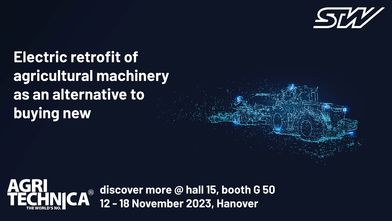Agricultural machinery is designed to be robust and for long lasting use. The machines often perform their service in the field over decades. If the machine owner wants to electrify their machinery, retrofitting an electric drive can be a sustainable and economical alternative to buying a new machine, especially for comparatively young or particularly cost-intensive machines.
Electrification of mobile machines is progressing steadily for some time. At Agritechnica 2017, for example, Fendt presented the first fully electric tractor, the e100 Vario. Machines with e-drives are particularly interesting for farmers or municipal operators, as these businesses often have the option of using self-produced electricity from renewable sources for charging batteries. Battery-electric vehicles are then not only interesting from a sustainability point of view, but above all from a total cost of ownership point of view.
An electric drive system inherently reduces the need for additional operating material and has fewer drive components. Compared to internal combustion engine drives, electric drive systems are of a simpler design, which has inherently less components. As well as diesel fuel, engine oil and AdBlue are also no longer necessary for operation. This reduces the maintenance effort and running costs for the machine operator. Additionally, when using self-produced electricity, the farms make themselves independent of price fluctuations on the energy market.
Acquisition of new machinery represents a considerable investment and agricultural machinery in particular typically has a very long operating life. Retrofitting machines that are already in use can be an economical way to benefit from the advantages of an electrified fleet. Retrofitting can also be especially worthwhile for large machines with very high acquisition costs.
In recent years, several companies have been established that specialize in retrofit solutions for mobile machinery. As the variety and complexity of machines is much greater than in the automotive sector, individually adapted solutions are usually required. Simply replacing a combustion engine with an electric drive and a battery is usually not practical, or would involve a considerable compromise in performance and efficiency. The best scenario is where the retrofit solution seamlessly replaces the conventional drive and brings with it further advantages. Typically, these might include better monitoring of the machine systems and recuperation of energy to feed back into the system resulting in an even more efficient machine.
Companies that offer effective retrofit solutions must be experts in system integration and need to utilize high quality components, especially in the control and monitoring of drives and energy flows. In order to offer the best systems possible, many integrators rely on the mobile controllers and communication modules from STW. For agricultural machinery, STW has developed the ESX.4cl-ag, a compact control system that is high-speed ISOBUS capable and is robust enough for rugged agricultural applications. To take advantage of Tractor Implement Management, STW recently introduced the BCX.4cs-ag on-board power distribution unit. A comprehensive sensor portfolio for monitoring pressure, temperature and accelerations are also part of the STW’s retrofit offering.
You can find out more about STW solutions for retrofit drive systems at Agritechnica in Hanover from 12 to 18 November at Stand G50 in Hall 15.
